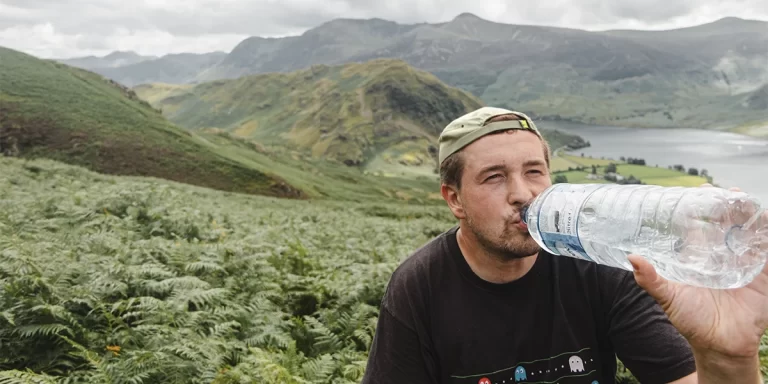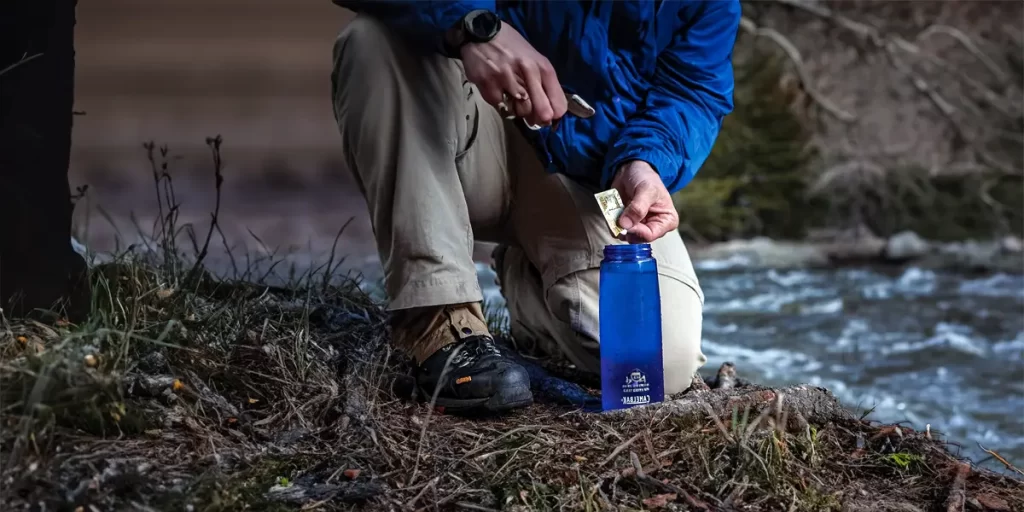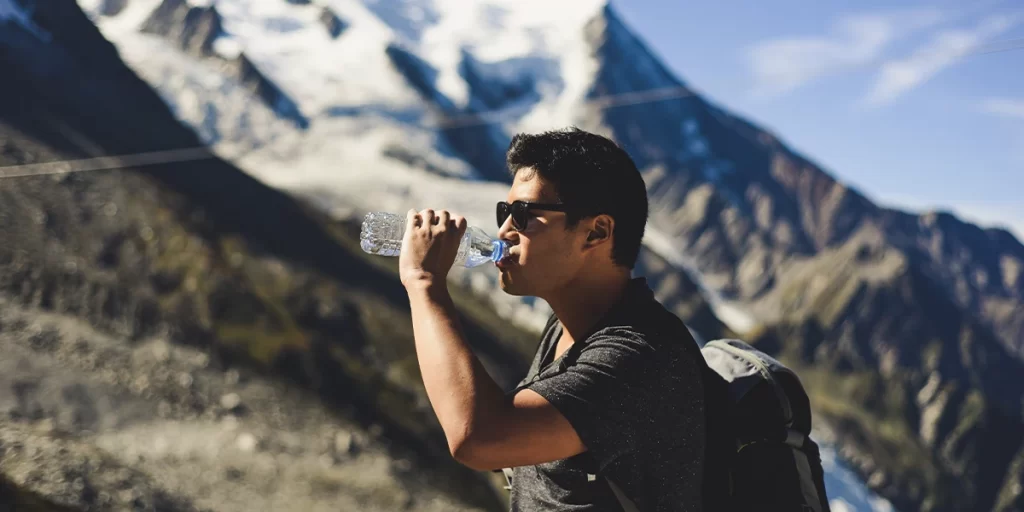

Picture yourself venturing into the wilderness. However, a significant challenge arises: finding safe drinking water.
The golden rule for hiking hydration is to drink one quart (950 ml) every two hours.
However, water is heavy. So, if you want to carry less weight and refill from a stream during your hike, you need to bring water purification tablets.
But how do water purification tablets work and what to consider when using them? In this post, we’ll cover it all. Let’s get started.

Water purification tablets contain active ingredients like chlorine, chlorine dioxide, or iodine that can neutralize harmful microorganisms in water.
When a tablet is added to water, the active ingredient is released and targets bacteria, viruses, parasites and other pathogens. It disrupts their structure and function, effectively killing or inactivating them. This process removes the health risk posed by consuming pathogen-contaminated water.
However, purification tablets do not work instantly. There is a waiting period, usually around 30 minutes, to allow the active ingredient time to be fully effective. During this time, the ingredient disables about 99% of the harmful microbes present in the water.
Once the waiting period is over, the water is purified and safe to drink. So it’s important to follow the instructions on the tablet packaging and wait the full recommended time before drinking the water after adding a tablet.
Remember that on average 1 tablet can treat ~1 quart of water.

Water Purification Tablets Pros:
Since their introduction in the 1940s, with collaboration between the US military and Harvard University, these tablets have proven to have many benefits:
Water Purification Tablets Cons:
Just like most things, even these tablets come with their share of drawbacks:
So, you might be wondering which purification tablets to get for your next adventure? Well, we’ve done the homework for you and listed the popular options among hikers and backpackers.
These choices don’t weigh much and dissolve pretty fast. They work against bacteria and viruses, but not all of them can keep you safe from protozoa.
| Brand / Product | Active Ingredient | Waiting period | Effective Against Protozoa |
|---|---|---|---|
| Aquamira (Liquid Drops) | Chlorine dioxide | 20 minutes | 4 hours for Cryptosporidium |
| Aquatabs | Sodium dichloroisocyanurate | 30 minutes | Giardia, but not Cryptosporidium |
| Potable Aqua | Tetraglycine hydroperiodide | 35 minutes | Giardia, but not Cryptosporidium |
| Katadyn Micropur MP1 | Chlorine dioxide | 4 hours | All types of protozoa |
As you can see, most of these faster options won’t protect you against Cryptosporidium. Therefore, you might need to boil the water or use a water filter additionally.
The quest for clean drinking water doesn’t have to be a daunting challenge. Water purification tablets, despite their small size, offer substantial benefits. They ensure your safety while minimizing the load in your backpack.
As you embark on your wilderness adventure, consider the pros and cons of the water purification tablets discussed in this post to decide whether they should be included in your gear. For us, they are always a crucial part of our emergency kit.
Looking for an ultralight way to filter water on the trail? Explore our TOP 5 guide, where we highlight the lightest water filters available.
While filtering water removes many contaminants, it may not make water completely safe to drink. Methods like commercial filters, cloth, or sand/charcoal can remove solids and some microbes. However, filters alone may not reliably eliminate all dangerous pathogens such as viruses, protozoa, and bacteria. Boiling, UV light disinfection, and chemical treatments can both filter and disinfect, but standalone filters cannot. To ensure safety when drinking water from an unknown or potentially unsafe source, it is recommended to add an extra step like boiling for 1-3 minutes, using disinfectant tablets, or employing a UV purifier after filtering. Combining filtration with other purification methods helps ensure the removal of all hazardous contaminants for safe drinking water.
Water purification tablets can expire, and their shelf life typically ranges from 2 to 5 years, depending on the manufacturer and specific product. It’s crucial to check the expiration date on the tablet packaging before use. Expired tablets may lose their potency and might not effectively purify water, potentially compromising your safety during outdoor adventures.
Both boiling water and using purification tablets can effectively disinfect and kill harmful bacteria, viruses, and protozoa in water to make it safer for drinking. Boiling water is very effective at disinfecting and killing pathogens if done properly, but requires a heat source and time. Water needs to be brought to a rolling boil for 1-3 minutes to ensure disinfection. Purification tablets containing chlorine dioxide or iodine are easy to transport and simple to use, requiring only 30 minutes of contact time to disinfect. However, some pathogens are more resistant to chemical disinfectants. Ultimately, boiling water is a low-cost, chemical-free way to reliably disinfect and purify water in most situations, while purification tablets provide a convenient alternative when boiling is not possible. Both methods have advantages and can play an important role in access to safe drinking water.
There are simple ways to purify water without chemicals. Boiling it for 1-3 minutes kills most harmful things. Putting water in the sun for 6 hours in a clear bottle also works. Letting water sit, then straining it through a cloth helps. A homemade filter with charcoal, sand, and gravel removes impurities. Solar disinfection in a bottle in sunlight for 1-2 days also works. Distillation, boiling water and collecting vapor, separates pure water from contaminants. With practice, these methods can make water from streams safe to drink.